Apply to Aakash iACST Scholarship Test 2024
NCERT Solutions for Class 10 Maths Chapter 7 Coordinate Geometry
Coordinate Geometry Class 10 NCERT Solutions
NCERT Solutions for Class 10 Maths Chapter 7 Coordinate Geometry, created by experts at Careers360, provide comprehensive study material for students preparing for the CBSE Class 10 board exam. Class 10 maths ncert solutions chapter 7 cover all exercises in the NCERT textbook and are easily accessible for download. The step-by-step answers for various types of questions in the NCERT textbook can help students achieve mastery of the topics in the coordinate geometry chapter. The Class 10 maths chapter 7 NCERT solutions can be of great help for the students. If students want NCERT solutions for other classes and subjects, they can get the solutions by clicking on the above link. Students must refer to the NCERT Class 10 Maths books and read all the topics without fail.
- Coordinate Geometry Class 10 NCERT Solutions
- NCERT Solutions for Class 10 Maths Chapter 7 Coordinate Geometry FDF Free Download
- Coordinate Geometry Class 10 - Important Formulae
- NCERT Solutions for Class 10 Maths Chapter 7 Coordinate Geometry (Intext Questions and Exercise)
- Summary Of Class 10 maths NCERT solutions chapter 7
- Key Features of class 10 maths ncert solutions chapter 7
- NCERT Solutions for Class 10 Maths - Chapter Wise
- NCERT Books and NCERT Syllabus
- Benefits of NCERT Solutions for Class 10 maths chapter 7 Coordinate Geometry
- NCERT solutions of class 10 subject wise
- NCERT Exemplar solutions - Subject wise

Also Read,
- NCERT Exemplar Solutions for Class 10 Maths Chapter Coordinate Geometry
- Coordinate Geometry Class 10 Mathematics Notes
NCERT Solutions for Class 10 Maths Chapter 7 Coordinate Geometry FDF Free Download
Coordinate Geometry Class 10 - Important Formulae
Distance Formulae:
For a line defined by two points A(x1, y1) and B(x2, y2), the distance between these points can be calculated using the formula:
Distance AB = √[(x2 − x1)2 + (y2 − y1)2]
Section Formula:
When a point P divides a line AB, with A(x1, y1) and B(x2, y2) as endpoints, in a ratio of m:n, the coordinates of point P can be found using the formula:
Point P = {(mx2 + nx1)/(m + n) ,(my2 + ny1)/(m + n)}
Midpoint Formula:
The midpoint of a line AB, defined by A(x1, y1) and B(x2, y2), can be determined using the following formula:
Midpoint P = {(x1+ x2)/2, (y1+ y2)/2}
SAT® | CollegeBoard
Registeration closing on 19th Apr for SAT® | One Test-Many Universities | 90% discount on registrations fee | Free Practice | Multiple Attempts | no penalty for guessing
TOEFL ® Registrations 2024
Thinking of Studying Abroad? Think the TOEFL® test. Save 10% on your TOEFL exam with ApplyShop gift cards!
Area of a Triangle:
Consider a triangle formed by points A(x1, y1), B(x2, y2), and C(x3, y3). The area of this triangle can be calculated using the formula:
Area ∆ABC = (1/2)|x1(y2 − y3) + x2(y3 – y1) + x3(y1 – y2)|
Free download NCERT Solutions for Class 10 Maths Chapter 7 Coordinate Geometry PDF for CBSE Exam.
NCERT Solutions for Class 10 Maths Chapter 7 Coordinate Geometry (Intext Questions and Exercise)
Class 10 maths ch 7 solutions Exercise: 7.1
Q1 (i) Find the distance between the following pairs of points : (2, 3), (4, 1)
Answer:
Given points: (2, 3), (4, 1)
Distance between the points will be:
Q1 (ii) Find the distance between the following pairs of points : (– 5, 7), (– 1, 3)
Answer:
Given points: (– 5, 7), (– 1, 3)
Distance between the points will be:
Q1 (iii) Find the distance between the following pairs of points :(a, b), (– a, – b)
Answer:
Given points: (a, b), (– a, – b)
Distance between the points will be:
Answer:
Given points: (0, 0) and (36, 15)
Distance between the points will be:
The distance between the two towns A and B is, thus 39 km for given towns location
and
.
Q3 Determine if the points (1, 5), (2, 3) and (– 2, – 11) are collinear.
Answer:
Let the points (1, 5), (2, 3) and (– 2, – 11) be representing the vertices A, B, and C of the given triangle respectively.
Therefore,
Since these are not satisfied.
As these cases are not satisfied.
Hence the points are not collinear.
Q4. Check whether (5, – 2), (6, 4) and (7, – 2) are the vertices of an isosceles triangle.
Answer:
The distance between two points is given by:
So, we have the following points: (5, – 2), (6, 4) and (7, – 2) assuming it to be the vertices of triangle A, B, and C respectively.
Therefore, AB = BC
Here two sides are equal in length.
Therefore, ABC is an isosceles triangle.
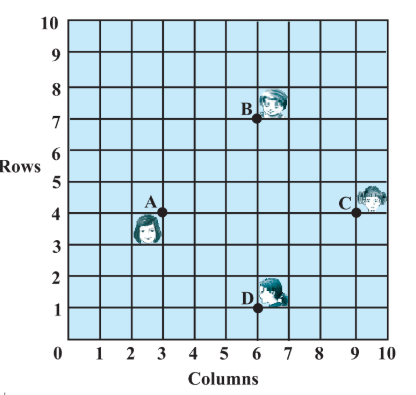
Answer:
The coordinates of the points:
are the positions of 4 friends.
The distance between two points is given by:
Hence,
And the lengths of diagonals:
So, here it can be seen that all sides of quadrilateral ABCD are of the same lengths and diagonals are also having the same length.
Therefore, quadrilateral ABCD is a square and Champa is saying right.
Answer:
Let the given points be representing the vertices A, B, C, and D of the given quadrilateral respectively.
The distance formula:
Finding the length of the diagonals:
It is clear that all sides are of the same lengths and also the diagonals have the same lengths.
Hence, the given quadrilateral is a square.
Q6 (ii) Name the type of quadrilateral formed, if any, by the following points, and give reasons for your answer: (–3, 5), (3, 1), (0, 3), (–1, – 4)
Answer:
Let the given points be representing the vertices A, B, C, and D of the given quadrilateral respectively.
The distance formula:
All the sides of the given quadrilateral have different lengths.
Therefore, it is only a general quadrilateral and not a specific one like square, rectangle, etc.
Q6 (iii) Name the type of quadrilateral formed, if any, by the following points, and give reasons for your answer: (4, 5), (7, 6), (4, 3), (1, 2)
Answer:
Let the given points be representing the vertices A, B, C, and D of the given quadrilateral respectively.
The distance formula:
And the diagonals:
Here we can observe that the opposite sides of this quadrilateral are of the same length.
However, the diagonals are of different lengths.
Therefore, the given points are the vertices of a parallelogram.
Q7 Find the point on the x-axis which is equidistant from (2, –5) and (–2, 9).
Answer:
Let the point which is equidistant from be
as it lies on X-axis.
Then, we have
Distance AX:
and Distance BX
According to the question, these distances are equal length.
Hence we have,
Solving this to get the required coordinates.
Squaring both sides we get,
Or,
Hence the point is .
Q8 Find the values of y for which the distance between the points P(2, – 3) and Q(10, y) is 10 units.
Answer:
Given the distance between the points and
is 10 units.
The distance formula :
So, given
After squaring both sides
Therefore, the values are .
Answer:
Given is equidistant from
and
.
Then, the distances .
Distance
Distance
Squaring both sides, we get
The points are:
CASE I: when R is
The distances QR and PR.
CASE II: when R is
The distances QR and PR.
Answer:
Let the point is equidistant from
and
.
Then, the distances
and
Squaring both sides: we obtain
Thus, the relation is between x and y.
Class 10 maths ch 7 solutions Exercise: 7.2
Q1 Find the coordinates of the point which divides the join of (–1, 7) and (4, –3) in the ratio 2 : 3.
Answer:
Let the coordinates of point which divides the line segment joining the points
and
, internally, in the ratio
then,
Section formula:
Substituting the values in the formula:
Here,
Hence the coordinate is .
Q2 Find the coordinates of the points of trisection of the line segment joining (4, –1) and (–2, –3).
Answer:
Let the trisection of the line segment and
have the points
and
Then,
Section formula:
By observation point, P divides AB internally in the ratio .
Hence,
Substituting the values in the equation we get;
And by observation point Q, divides AB internally in the ratio
Hence,
Substituting the values in the equation above, we get
Hence, the points of trisections are and

Answer:
Niharika posted the green flag at the distance P, i.e.,
from the starting point of
line.
Therefore, the coordinates of this point are
Similarly, Preet posted red flag at of the distance Q i.e.,
from the starting point of
line.
Therefore, the coordinates of this point Q are .
The distance is given by,
and the point at which Rashmi should post her Blue Flag is the mid-point of the line joining these points. Let this point be .
Then, by Section Formula,
Therefore, Rashmi should post her Blue Flag at 22.5 m on the 5th line.
Answer:
Let the ratio be :
Then, By section formula:
Given point
Hence, the point divides the line AB in the ratio
.
Answer:
Let the point on the x-axis be and it divides it in the ratio
.
Then, we have
Section formula:
Hence, the value of k will be:
Therefore, the x-axis divides the line in the ratio and the point will be,
Putting the value of in section formula.
Answer:
Let the given points .
Since the diagonals of a parallelogram bisect each other. Intersection point O of diagonal AC and BD also divides these diagonals.
Therefore, O is the mid-point of AC and BD.
The coordinates of the point O when it is mid-point of AC.
The coordinates of the point O when it is mid-point of BD.
Since both coordinates are of same point O.
Therefore,
and
Or,
Answer:
As the centre point will be the mid-point of the diameter AB.
Then, the coordinates of point A will be .
Given point .
Therefore,
.
Therefore, the coordinates of A are
Answer:
From the figure:

As
hence the ratio is 3:4,
Now, from the section formula, we can find the coordinates of Point P.
Section Formula:
Answer:
From the figure:

Points C, D, and E divide the line segment AB into four equal parts.
Now, from the section formula, we can find the coordinates of Point C, D, and E.
Section Formula:
Here point D divides the line segment AB into two equal parts hence
Now, point C divides the line segment AD into two equal parts hence
Also, point E divides the line segment DB into two equal parts hence
Answer:
From the figure:
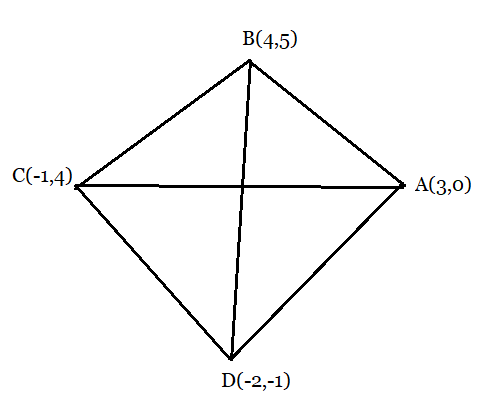
Let the vertices of the rhombus are:
Area of the rhombus ABCD is given by;
Hence we have to find the lengths of the diagonals AC and BD of the rhombus.
The distance formula:
Length of the diagonal AC:
Length of the diagonal BD:
Thus, the area will be,
Class 10 maths ch 7 solutions Exercise: 7.3
Q 1 (i) Find the area of the triangle whose vertices are : (2, 3), (–1, 0), (2, – 4)
Answer:
As we know, the area of a triangle with vertices (x1,x2) ,(y1, y2) and (z1 z2 ) is given by :
So Area of a triangle whose vertices are(2, 3), (–1, 0)and (2, – 4) is
Hence, the area of the triangle is 10.5 per unit square.
Q1 (ii) Find the area of the triangle whose vertices are (–5, –1), (3, –5), (5, 2)
Answer:
From the figure:

Area of the triangle is given by:
Substituting the values in the above equation, we obtain
Answer:
The points (7, –2), (5, 1), (3, k) are collinear if the area of the triangle formed by the points will be zero.
Area of the triangle is given by:
Substituting the values in the above equation, we obtain
Hence, the points are collinear for k=4 .
Answer:
The points (8,1), (k, -4), (2,-5) are collinear if the area of the triangle formed by these points will be zero.
Area of the triangle is given by:
Substituting the values in the above equation, we obtain
Hence, the points are collinear for k = 3 .
Answer:
From the figure:
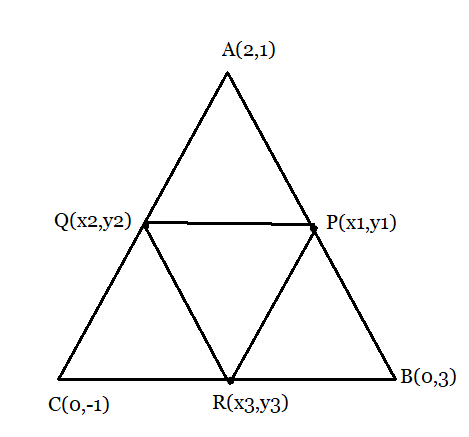
The coordinates of the point P, Q, and R are:
Point P is the midpoint of side AB, hence the coordinates of P are :
Point Q is the midpoint of side AC, hence the coordinates of Q are :
Point R is the midpoint of side BC, hence the coordinates of R are :
Hence, the area of the triangle formed by the midpoints PQR will be,
And the area formed by the triangle ABC will be:
Thus, the ratio of Area of to the Area of
will be
.
Answer:
From the figure:

The coordinates are
Divide the quadrilateral into 2 parts of triangles.
Then the area will be,
Area of the triangle formed by ABC will be,
Area of the triangle formed by ADC will be,
Therefore, the area of the quadrilateral will be:
Alternatively,
The points A and C are in the same ordinates.
Hence, the length of base AC will be
Therefore,
Area of triangle ABC:
Area of triangle ADC:
Therefore, the area will be,
Answer:
From the figure:

The coordinates of midpoint M of side BC is:
Now, calculating the areas of the triangle ABM and ACM :
Area of triangle, ABM:
Area of triangle, ACM:
However, the area cannot be negative, Therefore, area of is 3 square units.
Clearly, the median AM divided the in two equal areas.
Chapter 7 maths class 10 ncert solutions Exercise: 7.4
Answer:
Let the line divide the line segment AB in the ratio at point C.
Then, the coordinates of point C will be:
Point C will also satisfy the given line equation , hence we have
Therefore, the ratio in which the line divides the line segment joining the points
and
is
internally.
Q2 Find a relation between x and y if the points (x, y), (1, 2) and (7, 0) are collinear.
Answer:
If the points are collinear then, the area formed by these points will be zero.
The area of the triangle is given by,
Substituting the values in the above equation, we have
Or,
Hence, the required relation between x and y is .
Q3 Find the center of a circle passing through the points (6, – 6), (3, – 7) and (3, 3).
Answer:
From the figure:

Let the center point be .
Then the radii of the circle are equal.
The distance OA:
The distance OB:
The distance OC:
Equating the radii of the same circle.
When equating,
Squaring both sides and applying
or
...................................(1)
When equating,
Squaring both sides and applying
...................................(2)
Now, adding the equations (1) and (2), we get
.
From equation (1), we get
Therefore, the centre of the circle is .
Answer:
From the figure:
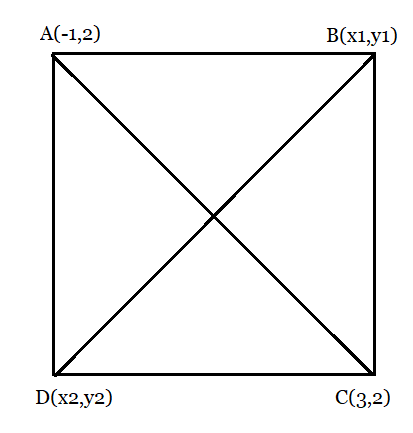
We know that the sides of a square are equal to each other.
Therefore, AB = BC
So,
Squaring both sides, we obtain
Now, doing
We get
Hence .
Applying the Pythagoras theorem to find out the value of y.

Answer:
Taking A as origin then, the coordinates of P, Q, and R can be found by observation:
Coordinates of point P is
Coordinates of point Q is
Coordinates of point R is
The area of the triangle, in this case, will be:

Answer:
Taking C as origin, then CB will be x-axis and CD be y-axis.
The coordinates fo the vertices P, Q, and R are: respectively.
The area of the triangle, in this case, will be:
It can be observed that in both cases the area is the same so, it means that the area of any figure does not depend on the reference which you have taken.
Answer:
From the figure:
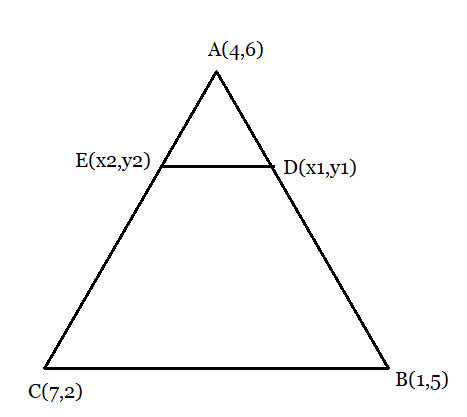
Given ratio:
Therefore, D and E are two points on side AB and AC respectively, such that they divide side AB an AC in the ratio of .
Section formula:
Then, coordinates of point D:
Coordinates of point E:
Then, the area of a triangle:
Substituting the values in the above equation,
Hence the ratio between the areas of and
is
Answer:
From the figure:
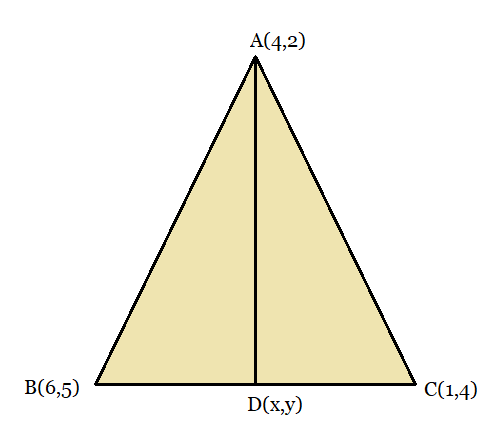
Let AD be the median of the triangle
Then, D is the mid-point of BC
Coordinates of Point D:
Answer:
From the figure,
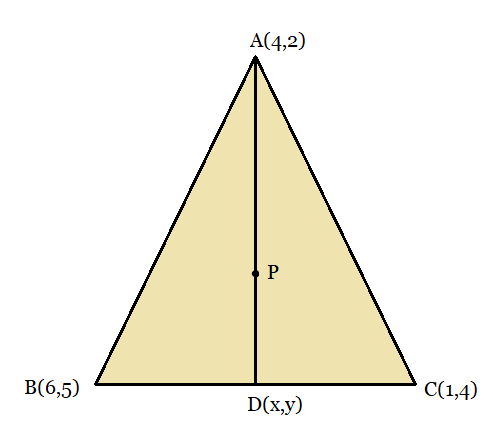
The point P divides the median AD in the ratio, AP: PD = 2: 1
Hence using the section formula,
Answer:
From the figure,
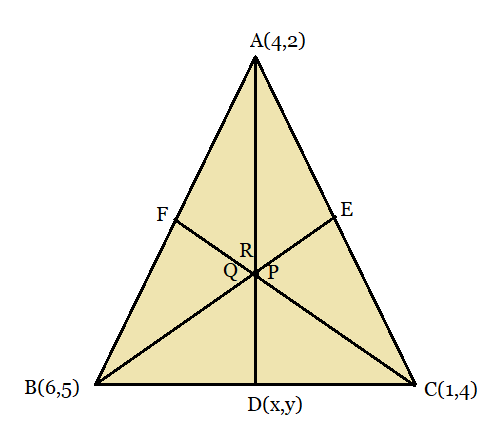
The point Q divides the median BE in the ratio, BQ : QE = 2 : 1
Hence using the section formula,
The point R divides the median CF in the ratio, CR: RF = 2: 1
Hence using the section formula,
Q7 (iv) Let A (4, 2), B(6, 5) and C(1, 4) be the vertices of D ABC. What do you observe?
Answer:
We observed that the coordinates of P, Q, and R are the same. Therefore, all these are representing the same point on the plane. i.e., the centroid of the triangle.
Answer:
From the figure, 
Let the median be AD which divides the side BC into two equal parts.
Therefore, D is the mid-point of side BC.
Coordinates of D:
Let the centroid of this triangle be O.
Then, point O divides the side AD in a ratio 2:1.
Coordinates of O:
Answer:
From the figure:

P is the mid-point of side AB.
Therefore, the coordinates of P are,
Similarly, the coordinates of Q, R and S are: respectively.
The distance between the points P and Q:
and the distance between the points Q and R:
Distance between points R and S:
Distance between points S and P:
Distance between points P and R the diagonal length:
Distance between points Q and S the diagonal length:
Hence, it can be observed that all sides have equal lengths. However, the diagonals are of different lengths.
Therefore, PQRS is a rhombus.
Summary Of Class 10 maths NCERT solutions chapter 7
Coordinate Geometry is one of the important chapters for higher mathematics in upcoming classes. You will use at least some part of coordinate geometry in the field whether you are going to study commerce, engineering, maths, medical, arts, etc. Class 10 NCERT solutions Maths chapter 7 is designed to give you a step by step solution for a particular question. In Coordinate Geometry, you will study the algebraic forms of geometric figures. There are four exercises to solve from the NCERT book chapter 7 Maths Class 10. The exercises are listed below
- Coordinate Geometry Class 10 Exercise 7.1
- Coordinate Geometry Class 10 Exercise 7.2
- Coordinate Geometry Class 10 Exercise 7.3
- Coordinate Geometry Class 10 Exercise 7.4
Key Features of class 10 maths ncert solutions chapter 7
The NCERT class 10 Coordinate Geometry includes several key features to aid students in their understanding and practice of the material.
Class 10 maths chapter 7 example 9 provide answers to all exercise questions in the NCERT textbook.
Class 10 maths ch 7 solutions include diagrams and alternate methods to help students understand the concepts.
Chapter 7 maths class 10 pdf solutions help to familiarise students with important formulas and standards.
Class 10 chapter 7 ncert solutions include a variety of examples to help students connect the geometry and numerical concepts to real-life scenarios.
Memorise the formula to find out some directly asked questions.
NCERT Solutions for Class 10 Maths - Chapter Wise
Chapter No. | Chapter Name |
Chapter 1 | |
Chapter 2 | |
Chapter 3 | |
Chapter 4 | |
Chapter 5 | |
Chapter 6 | |
Chapter 7 | Coordinate Geometry |
Chapter 8 | |
Chapter 9 | |
Chapter 10 | |
Chapter 11 | |
Chapter 12 | |
Chapter 13 | |
Chapter 14 | |
Chapter 15 |
NCERT Books and NCERT Syllabus
How to use NCERT Solutions for Class 10 maths chapter 7 Coordinate Geometry?
Students can follow the steps provided below to use the class 10 maths ncert solutions chapter 7 in the best way possible.
Go through the concepts and examples given in the textbook to understand the basics of the chapter.
Memorize the formula to find out some directly asked questions.
During the practice of exercises, you can take the help of NCERT solutions for class 10 Maths chapter 7.
Now, students can practice the previous year's question to boost your preparation.
Benefits of NCERT Solutions for Class 10 maths chapter 7 Coordinate Geometry
Students will be able to study in a strategic way after accessing Class 10 Maths NCERT solutions chapter 7.
Class 10 Maths chapter 7 NCERT solutions are solved by the subject-matter experts and are very reliable at the same time.
NCERT solutions for class 10 maths chapter 7 Coordinate Geometry is designed to give the students step by step solution for a particular question.
In Coordinate Geometry, students will study the algebraic forms of geometric figures.
NCERT solutions of class 10 subject wise
NCERT Exemplar solutions - Subject wise
Frequently Asked Question (FAQs)
The chapter 7 maths class 10 ncert solutions are designed to align with the current CBSE syllabus and include detailed explanations for each question. Practising these NCERT solutions for Class 10 Maths will help students improve their exam skills and time management, making them more likely to score well on the exam. Additionally, working through these solutions of maths chapter 7 class 10 can help students become more familiar with the exam format, giving them more confidence when taking the test.
NCERT coordinate geometry class 10 ncert solutions covers several key topics, including Introduction to Coordinate Geometry, Distance Formula, Section Formula, and Area of the Triangle. Through a thorough study of these solutions of class 10 chapter 7 maths, students will gain the skills necessary to easily solve complex problems related to these topics.
Yes, It is essential to practise all the exercises in coordinate geometry class 10 chapter 7 Maths because they include a variety of questions that may appear in the CBSE board examination. By solving these exercises of chapter 7 class 10 maths, students will increase their chances of success on the final exams and feel more confident when taking the test. You can also study NCERT solutions for class 10 maths chapter 7 in hindi medium if you are facing issue with english medium.
First, you should try to solve every problem on your own including examples given in the NCERT textbook. Once you complete the entice syllabus, you must solve CBSE previous years paper in order to get familiar with the exam. For ease students can download chapter 7 Maths class 10 pdf solutions and study both online and offline mode.
Also Read
Articles
Certifications By Top Providers
Explore Top Universities Across Globe
Questions related to CBSE Class 10th
Dear aspirant !
Hope you are doing well ! The class 10 Hindi mp board sample paper can be found on the given link below . Set your time and give your best in the sample paper it will lead to great results ,many students are already doing so .
Hope you get it !
Thanking you
Hello aspirant,
The dates of the CBSE Class 10th and Class 12 exams are February 15–March 13, 2024 and February 15–April 2, 2024, respectively. You may obtain the CBSE exam date sheet 2024 PDF from the official CBSE website, cbse.gov.in.
To get the complete datesheet, you can visit our website by clicking on the link given below.
https://school.careers360.com/boards/cbse/cbse-date-sheet
Thank you
Hope this information helps you.
Hello aspirant,
The paper of class 7th is not issued by respective boards so I can not find it on the board's website. You should definitely try to search for it from the website of your school and can also take advise of your seniors for the same.
You don't need to worry. The class 7th paper will be simple and made by your own school teachers.
Thank you
Hope it helps you.
The eligibility age criteria for class 10th CBSE is 14 years of age. Since your son will be 15 years of age in 2024, he will be eligible to give the exam.
That totally depends on what you are aiming for. The replacement of marks of additional subjects and the main subject is not like you will get the marks of IT on your Hindi section. It runs like when you calculate your total percentage you have got, you can replace your lowest marks of the main subjects from the marks of the additional subject since CBSE schools goes for the best five marks for the calculation of final percentage of the students.
However, for the admission procedures in different schools after 10th, it depends on the schools to consider the percentage of main five subjects or the best five subjects to admit the student in their schools.
Popular CBSE Class 10th Questions
Colleges After 12th
Also Read
Applications for Admissions are open.

JEE Main Important Physics formulas
ApplyAs per latest 2024 syllabus. Physics formulas, equations, & laws of class 11 & 12th chapters

UPES School of Liberal Studies
ApplyRanked #52 Among Universities in India by NIRF | Up to 30% Merit-based Scholarships | Lifetime placement assistance

Aakash iACST Scholarship Test 2024
ApplyGet up to 90% scholarship on NEET, JEE & Foundation courses

JEE Main Important Chemistry formulas
ApplyAs per latest 2024 syllabus. Chemistry formulas, equations, & laws of class 11 & 12th chapters

PACE IIT & Medical, Financial District, Hyd
ApplyEnrol in PACE IIT & Medical, Financial District, Hyd for JEE/NEET preparation

ALLEN JEE Exam Prep
ApplyStart your JEE preparation with ALLEN
